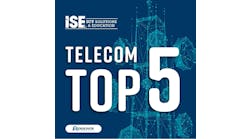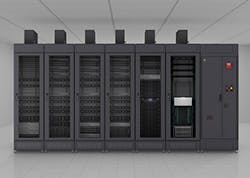The term Infrastructure is sometimes used broadly to describe the full spectrum of equipment, people and facilities required to support communications or data processing. This article uses a narrower definition: the systems that enable digital technologies, such as critical infrastructures, compute, storage, and communications equipment, to operate safely and without disruption.
Critical infrastructure includes power management, thermal management, associated software and controls, integration, and services. Whether in a data center, central office, edge computing location, or cell tower, these systems play a vital role in supporting your customers and employees. Without them, you simply can’t deliver applications and services reliably.
Yet the impact of these systems extends beyond uptime, particularly in today’s dynamic communications landscape in which mobile technologies, Cloud computing, and the Internet of Things (IoT) are increasing demands on networks. Your data centers and networks are only as flexible and scalable as the infrastructure that supports them.
Here are 3 ways critical infrastructure technologies are evolving to deliver the flexibility and cost efficiency that you need to stay ahead of market demands and to capitalize on new opportunities.
1. Integration cuts deployment times and enhances manageability
Across every industry, we are seeing increased demand for edge computing and communications to speedup content delivery and support the connected devices comprising the IoT. These edge facilities range from network closets to mini data centers to mid-size regional data centers.
These facilities share some common traits. First, they typically represent a response to growing demand for localized communication, computing, and storage. As such, speed of deployment becomes a high priority. Move too slowly in responding to demand and you miss opportunities or enable competitors.
In addition, as these locations proliferate, the need for standardization and remote management increases. Many of these sites are not supported by on-site technical resources, and are in facilities not designed for electronic equipment.
Those factors have driven the growth of prefabricated, fully integrated systems that provide plug-and-play environments for compute and communications equipment. Telecommunications was an early adopter of containerized data centers, so this trend is not particularly new in that regard. However, the range of fully integrated solutions now available has expanded considerably since containers were introduced.
Figure 1. Integrated systems, such as the Vertiv™ SmartRow™, are allowing providers to meet the demand for edge computing faster and with greater standardization.
From compact cabinets to single racks to enclosed row systems to full containers, integrated systems are now available for virtually every edge application, and are allowing providers to deploy technology faster than was previously possible. These systems also typically include integrated monitoring and management capabilities, an important feature for organizations managing multiple edge facilities from a centralized location. (See Figure 1.)
This shift from on-site to factory integration has even extended to standalone data center development. Traditional stick-build processes have proven too inefficient and time-consuming for many organizations seeking to add large blocks of new capacity. Thus, a more streamlined process has emerged in which entire facilities, including critical infrastructure, are designed as modules that are prefabricated off-site and then shipped to the site for assembly and commissioning. This approach has cut development times by approximately 30%, and results in tightly integrated, highly efficient data centers. (See Figure 2.)
Figure 2. The T-Systems 1.1 MW Cloud data center in Barcelona was designed and constructed in 9 months using pre-fabricated modules assembled on-site.
As telecommunications providers and data center operators respond to continued growth in network traffic and computing requirements, infrastructure integration represents a powerful strategy that can increase speed of response, and improve efficiency and management.
This trend does, however, raise the bar for infrastructure service providers. Executing on this strategy, requires a service partner with a broad network of local service specialists capable of delivering configuration, installation, and maintenance support across both AC and DC power systems, thermal management, as well as the sophisticated engineering and project management capabilities required to address complex integration and prefabrication challenges.
2. Intelligent infrastructure enables software-defined networking
Software-defined networking (SDN) promises to bring many of the same benefits to communications networks as virtualization has provided for data centers. Yet, as with data centers, that agility comes with some risk: if infrastructure systems aren’t able to support shifts in traffic, the ability to leverage SDN is compromised.
This is being addressed in the data center by a new generation of infrastructure technologies using embedded intelligence, advanced controls, and established and emerging protocols to enable communication and coordination across systems and devices. The resulting real-time visibility into and control over systems across locations enables software-defined management in which loads can be shifted with confidence and infrastructure can dynamically respond to changing conditions to optimize efficiency and availability.
This same approach can ultimately support SDN. In fact, telecommunications networks and data centers may eventually use the same specification for device management. The DMTF Redfish specification, released in 2015, was developed to address limitations inherent in the legacy IPMI specification for server management. The developers accomplished that objective while also creating a simple, versatile specification that can be extended beyond servers to other devices, including communications and infrastructure systems.
3. Lithium ion batteries (finally) achieve viability
Lithium ion batteries are not new but recent advances in chemistry and construction, combined with declining prices, could cause telecommunications providers and data center operators to revisit the technology as a viable option to valve-regulated lead acid (VRLA) batteries for backup power applications.
Compared to the VRLA batteries, lithium ion batteries pack more energy into a smaller space, thus reducing the footprint of backup power systems. They also last significantly longer, can typically tolerate higher operating temperatures and require less maintenance.
Even with declining prices, the initial costs for lithium ion batteries are approximately 1.5 to 2.0 times higher than VRLA batteries. However, operational savings in the areas of service and maintenance, reduced floor space, and longer lifespans, can more than offset the difference in initial costs.
There are multiple applications in telecommunications networks and data centers where lithium ion batteries can deliver real benefits, and the technology has now advanced to the point where it can be considered.
Critical infrastructure is not the most glamorous segment of the telecommunications industry, but it is one of the most critical. With the continued demands on data centers and telecommunications networks created by Cloud computing, mobile data and connected devices, critical infrastructure must be flexible and dynamic enough to meet the challenges of today while easily adapting to the needs of the future. Today’s systems can accomplish that.
Save
Save







